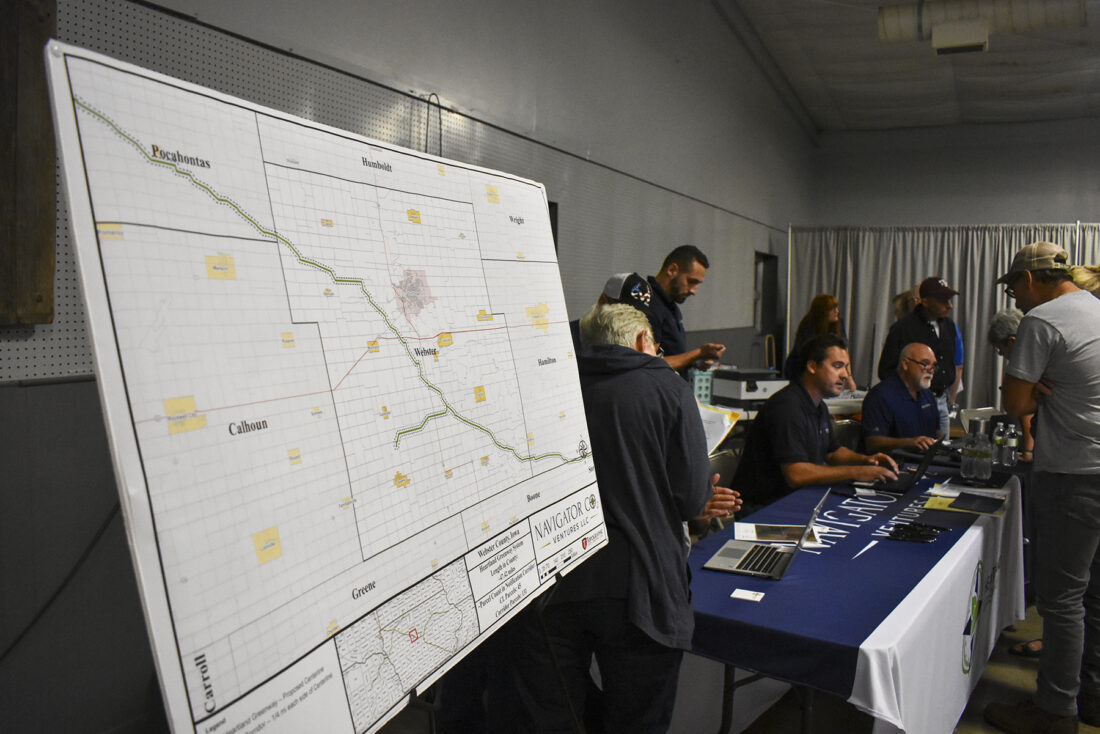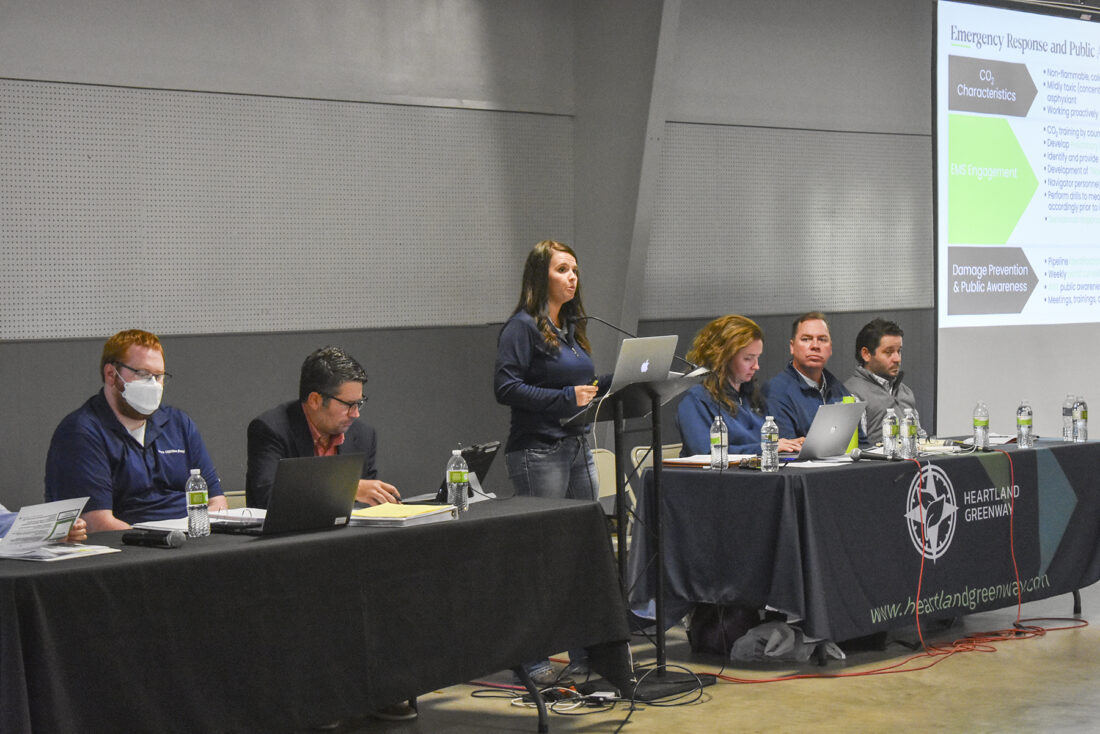CO2 pipeline update
Navigator, IUB hold informational meeting
-
-Messenger photo by Kelby Wingert
A map shows how the proposed Heartland Navigator CO2 pipeline would cross through Webster County. The Iowa Utilities Board and Navigator hosted an informational meeting Thursday night at the Webster County Fairgrounds.
-
-Messenger photo by Kelby Wingert
Monica Howard, senior director of environmental and regulatory for Navigator CO2, answers a question asked by Webster County Supervisor Keith Dencklau during an informational meeting on Navigator’s proposed Heartland Greenway pipeline on Thursday.
-
-Messenger photo by Kelby Wingert
Elizabeth Burns-Thompson, vice president of government and public affairs for Navigator CO2, gives a presentation on the proposed Heartland Greenway carbon capture pipeline during an informational meeting at the Webster County Fairgrounds on Thursday evening.

-Messenger photo by Kelby Wingert
A map shows how the proposed Heartland Navigator CO2 pipeline would cross through Webster County. The Iowa Utilities Board and Navigator hosted an informational meeting Thursday night at the Webster County Fairgrounds.
Area residents and landowners who would be impacted by a proposed carbon capture pipeline running through Webster County were given the opportunity to ask questions about the project to the company proposing the pipeline and the government board that will ultimately be responsible for approving the pipeline’s permit.
Navigator CO2 is proposing its new Heartland Greenway liquid CO2 pipeline, which will pass through about a third of the state of Iowa and diagonally bisect Webster County.
The 1,300-mile-long pipeline, which will start in South Dakota and Nebraska, will run about 810 miles through Iowa and end in central Illinois, where the pressurized liquid CO2 will be injected into an underground sandstone reservoir formation known as Mt. Simon. The proposed pipeline includes 47.42 miles that runs through the northwest corner to the southeast corner of Webster County.
Around 150 people attended Thursday’s informational meeting at the Webster County Fairgrounds.
Iowa Utilities Board Member Josh Byrnes gave a presentation of the process through which companies seeking a hazardous liquid pipeline permit must go, as well as the legal rights of impacted landowners.

-Messenger photo by Kelby Wingert
Monica Howard, senior director of environmental and regulatory for Navigator CO2, answers a question asked by Webster County Supervisor Keith Dencklau during an informational meeting on Navigator’s proposed Heartland Greenway pipeline on Thursday.
Following that, Elizabeth Burns-Thompson, Navigator’s vice president for government and public affairs, gave a presentation explaining the carbon capture process and the pipeline project.
According to Burns-Thompson, there are 21 ethanol and fertilizer plants along the whole project, including Valero Renewables and Poet, who have signed on to be carbon capture sites, where the CO2 produced by the plants’ current operations is pressurized into a liquid form and put into the pipeline to travel to the storage reservoir in Illinois.
She said that what was once known as “by-products” of ethanol production are now known as “co-products” as uses for those by-products have been developed over the years.
Burns-Thompson noted that ethanol plants today look much different than they did 20 years ago.
“They continue to optimize and innovate to remain competitive,” she said. “We see carbon capture as being a necessary step of that innovation processes moving forward.”

-Messenger photo by Kelby Wingert
Elizabeth Burns-Thompson, vice president of government and public affairs for Navigator CO2, gives a presentation on the proposed Heartland Greenway carbon capture pipeline during an informational meeting at the Webster County Fairgrounds on Thursday evening.
Navigator estimates it will transport up to 15 million metric tons of liquid CO2 through the pipeline annually. The company says the project will be a $1.79 billion investment in Iowa, including $1.85 million annually in Webster County. The project would create 5,000 temporary construction jobs and 50 permanent jobs, according to Navigator.
Now that Navigator has held a public informational meeting, they can start contacting landowners along the proposed route and attempt negotiations for right-of-way easements on their properties.
“We are committed to being collaborative, respectful and negotiating in good faith at every step in this process, and all we ask is for that in return,” Burns-Thompson said.
Landowners are not required to enter into voluntary easements with Navigator. However, the company can ask the IUB to utilize eminent domain, or the process of taking private property for public use.
According to Burns-Thompson, the landowners who enter into voluntary easements will receive 20% of the easement payment immediately after signing, with the remaining 80% to be paid prior to construction, or through a 20-year annual payment plan. The landowner will be able to chose which payment option they wish to receive, she said.
Landowners impacted by the construction of the pipeline will also receive 250% compensation of the five-year crop yield loss prior to construction as well. One landowner in attendance asked what if the crop yield loss extends past five years — would the landowner continue to be compensated? Burns-Thompson said they would continue to receive compensation for yield loss.
“We are responsible for the impacts of the design, construction, as well as operations of this line,” she said.
Burns-Thompson also highlighted some of the safety features of the project, including that the pipeline will be buried at a minimum depth of five feet — and in many areas will be much deeper. The pipeline will be made of steel pipe made specifically for liquid CO2. There will also be strategically located mainline valves that can be closed if a problem occurs.
“There are absolutely risks associated with just about everything in day-to-day life, and the development of infrastructure and projects like this included,” she said. “However, we do believe we are proactively mitigating any of those risks.”
State Sen. Tim Kraayenbrink, R-Fort Dodge, asked the Navigator representatives what would happen if the pipeline project was purchased by another company from Navigator, or if Navigator was bought by a larger company.
Burns-Thompson answered that because the easement with the landowner is a contract, any purchaser would be required to honor the terms of the contract made between the landowner and Navigator. She also said that any sale of the pipeline would have to be approved by the IUB.
One landowner came up to the mic and asked the audience how many of them were against the pipeline proposal. About a third of those in attendance raised their hands.
The subject of eminent domain was not prominent during Thursday’s meeting. Though, at one point, an attendee asked if there was a threshold of how many voluntary easements the company would need to obtain before asking the IUB to utilize eminent domain.
Byrnes said there isn’t a threshold or minimum number of voluntary easements needed to ask for eminent domain on uncooperative landowners.
A previous meeting was held at the Best Western Starlite on Dec. 14, 2021. However, because the planned route for the Navigator pipeline has changed, a new informational meeting was required.
The proposed pipeline’s original route included about 900 miles through Iowa and passed through 36 counties. The current proposed route reduces that to 810 miles through 33 Iowa counties.
The pipeline project is in its earliest stages. Now Navigator can begin contacting landowners to negotiate voluntary easements. The company projects a late October filing date for its hazardous liquid pipeline permit application through the IUB. Navigator plans to apply for federal permits later this year and anticipate to receive the required permits by the second half of 2023. If the permits are granted, construction on the pipeline will start in the first half of 2024, with the pipeline operational near the beginning of 2025.







